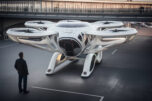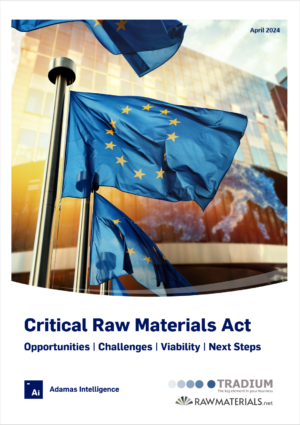What are hot-deformed NdFeB magnets?
Made from powder like bonded, fully dense like sintered, but they're neither: Hot-deformed NdFeB magnets are a third type of widely produced NdFeB magnet that exhibits some of the best properties of both bonded and sintered varieties. Adamas research indicates that the outlook for use of hot-deformed NdFeB magnets is promising, boding well for NdFeB powder demand in the years to come.

Made from powder like bonded, fully dense like sintered, but they’re neither: Hot-deformed NdFeB magnets are a third type of widely produced NdFeB magnet that exhibits some of the best properties of both bonded and sintered varieties.
Adamas research indicates that the outlook for use of hot-deformed NdFeB magnets is promising, boding well for NdFeB powder demand in the years to come.
A third type of NdFeB magnet
Hot-deformed NdFeB magnets are made from NdFeB powder produced by the rapid quenching method (e.g., melt-spun MQU powder from Neo Magnequench) that is formed into magnets using thermomechanical processes (e.g., cold pressing, hot pressing and hot extrusion) that may vary from company to company. As with bonded magnets, production of hot-deformed varieties produces minimal NdFeB waste, however, unlike bonded magnets, hot-deformed incumbents are fully dense meaning that they contain no bonding agents that would otherwise dilute the magnet’s maximum energy product.
As such, hot-deformed fully dense NdFeB magnets provide “magnetic properties similar to those found in sintered NdFeB magnets” but come with the added benefit of being “able to reach higher performance levels with zero or significantly reduced heavy rare earth content, which enables lower costs throughout the supply chain”, according to the world’s leading producer of NdFeB powders, Neo Performance Materials.
Unlike sintering of NdFeB, “the hot deformation method is a technology that enables nanometer-scale crystal grains to be well-aligned in order to realize a fine crystal grain structure that is approximately ten times smaller than that of a sintered magnet, which makes it possible to produce magnets with greater heat resistance properties” says Daido Electronics, a wholly owned subsidiary of Daido Steel that has been mass-producing neodymium magnets using the hot deformation method for more than a decade.
Hot-deformed fully dense NdFeB magnets (also known as hot-pressed or hot-extruded magnets) are often produced in the form of radially oriented, anisotropic ring magnets that are widely used in electronic power steering (EPS) motors for automobiles, and other servomotors, spindle motors, generators and more.
Other form factors, such as hot-deformed bar-shaped magnets, have been used in HEV traction motors – most notably those of Honda – since commercialization of magnets for EV motors by Daido Electronics in 2016.

Superior to sintered and bonded NdFeB magnets
Hot-deformed NdFeB ring magnets (and other magnet form factors discussed below) are superior to sintered NdFeB magnets for multiple reasons and, on the basis of magnetic strength, are far superior to bonded NdFeB magnets.
Diameter: Hot-deformed NdFeB ring magnets can be produced with a smaller outer diameter than sintered NdFeB magnets and unlike sintered varieties, the strength of hot-deformed rings does not weaken with decreasing diameter making them ideal for magnets with a diameter of less than 15mm, as well as larger applications.
Wall thickness: Hot deformation processes allow for production of thinner ring magnet walls without affecting the magnet’s surface magnetism, allowing for use of less magnetic material to achieve the desired properties. Conversely, the magnetic saturation of sintered NdFeB magnets is affected by wall thickness thus often needs be thicker than a hot-deformed equivalent.
Robustness: Hot-deformed ring magnets have higher corrosion resistance than their sintered counterparts, as well as higher toughness and flexural strength, making them more robust all around.
Cost-performance: Hot-deformed magnets of all form factors typically offer a better cost-performance balance attributed to their higher resource utilization and greater temperature resistance compared to sintered NdFeB magnets of the same performance.
HREE supply risks: Hot-deformed magnets can be produced with little-to-no heavy rare earths while achieving higher performance than a sintered equivalent, reducing heavy rare earth input costs and supply risks.
Assembly: For motor manufacturers, assembly using a hot-deformed ring magnet is simplified versus assembly with numerous sintered magnet pieces per motor. The magnets are temperature resistant up to 200 degrees Celsius and require no additional protection for motor use up to 12k RPM.

Not just for rings; also loaves, plates, arcs and other shapes
In addition to ring magnets, leaders in the space like Daido Electronics have developed hot-deformed NdFeB magnets in a variety of other shapes and orientations, such as arcs, bars, plates, loafs and fans, expanding the array of current and potential uses while bolstering the competitiveness of hot-deformed NdFeB versus sintered for a greater number of applications.
In our view, hot-deformed NdFeB magnets, and the powder market that supplies them, are poised to benefit from the ongoing acceleration of robotics and advanced air mobility sectors.

Robotics and advanced air mobility to accelerate demand
In a humanoid robot, there are a variety of different motors and actuators used throughout, and the number of motors and actuators used per robot is increasing over time. For smaller linear actuators and servomotors, we see potential for growing use of hot-deformed NdFeB ring magnets, and in some cases bonded NdFeB magnets, contributing to a re-acceleration of NdFeB powder demand in the years ahead.
Moreover, in the case of motors for commercial drones and eVTOL aircraft, their requirements also bode well for continued use of permanent magnet motors, particularly axial flux motors and surface mounted radial flux motors. For the latter, as with actuators and motors for robots, we again see potential for growing use of hot-deformed NdFeB ring magnets, and other forms, helping contribute to a re-acceleration of NdFeB powder demand (i.e. the precursor for hot-deformed and bonded magnets) in the coming years.

More information?
Check our latest Rare Earth Magnet Market Outlook to 2040 annual report – the industry’s go-to reference for magnet market intelligence.






